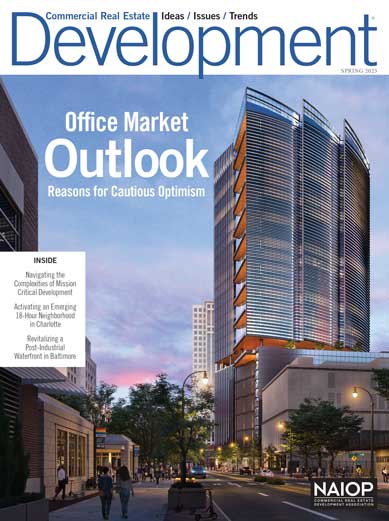Listening to clients and employees has resulted in consistently high occupancy rates for this Maryland-based CRE developer.
Fall 2018 Issue
The Municipal Benefits of Urban Fulfillment Centers
By: Camille GaldesCity leaders should be more proactive in crafting municipal policies that capitalize on the e-commerce changes transforming commercial real estate and their tax bases.
Boston Scientific's Global Customer Fulfillment Center
By: Paul Donhauser and Marc MarguliesA global facilities master plan informs the company’s real estate decisions.
The Value of Downtown Data Centers
By: Marc GittlemanBuildings with direct fiber-optic internet connections will benefit from strong demand as information continues to be stored in the cloud and big data takes off.
Must-Read Articles

Tenants Ponder: Should I Stay or Should I Go?

Agree to Disagree: Resolving Property Disputes with a Partition Action

Designing Spaces to Create Great Experiences

How to Attract Institutional Capital Through the Development of Operating Guidelines

Networked Electric Vehicle Charging Stations
RELATED RESEARCH AND PUBLICATIONS
From Static to Strategic: AI’s Role in Next-Generation Industrial Real Estate
- Report,
- Technology,
- ...
Industrial Space Demand Forecast, Third Quarter 2025
Economic Impacts of Commercial Real Estate in Canada, 2025 Edition
PERSPECTIVES
CEO on Leadership: Daniel J. Moore, President and CEO, Rockefeller Group
Six Students Receive NAIOP Diversity Scholarships
Industrial Properties Continue to Sizzle
Sound Bites from NAIOP’s I.CON: Industrial Conference
ADDITIONAL ARTICLES
Unified Commerce: The Future of Retail?
Retail Leasing: Minimizing Time, Cost and Risk
Autonomous Trucking's Effect on Industrial Real Estate
How to Future-Proof the Workplace
Creditworthy Tenants Yield Financing Alternatives
Invest in Opportunity: Invest in Rural America
Cookie Cutter Environmental Diligence Doesn't Cut It Anymore
New & Noteworthy Projects
Esports Arenas Have Entered the Game
ARCHIVED ISSUES
View All Archived Issues Summer 2025 Issue
Summer 2025 Issue
Development’s summer 2025 issue explores experiential retail and the brick-and-mortar resurgence. Also featured: a modern warehouse campus in Toronto that honors its manufacturing heritage; a coalition of Oregon real estate organizations working to revitalize downtown Portland; and the creative capital stack strategy behind a mixed-use project in West Baltimore.
 Spring 2025 Issue
Spring 2025 Issue
The spring 2025 issue offers insights about where the office market might be heading over the coming year, explores the complexities of mission critical development, and provides detailed looks at two transformative mixed-use projects: The Bowl at Ballantyne in Charlotte and Baltimore Peninsula in Maryland.
 Winter 2024/2025 Issue
Winter 2024/2025 Issue
Development magazine’s winter issue delves into the evolving uses of artificial intelligence in the commercial real estate industry, from lease management and building operations to portfolio assessment and data analysis.









